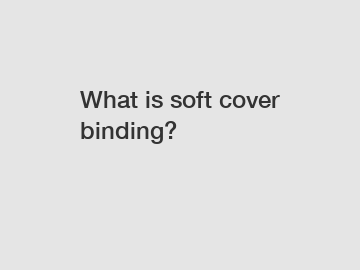What is soft cover binding?
What is Soft Cover Binding?
Are you curious about what soft cover binding really is? If so, you've come to the right place. In this article, we will delve into the intricacies of soft cover binding and explore its features, advantages, and common uses. So, let's jump right in!
Soft cover binding refers to a bookbinding method where a flexible cover, typically made of paper or cardstock, is glued or sewn to hold the pages together. Unlike hardcover binding, which uses a rigid cover, soft cover binding offers a lightweight and more cost-effective solution for various types of publications.

What are the key points to know about soft cover binding?
1. Flexibility and Portability:
One of the main advantages of soft cover binding is its flexibility. The soft cover allows the book to easily open and lie flat, which enhances readability and convenience. Additionally, the lightweight nature of softcover books makes them highly portable. This feature is particularly advantageous for travel guides, textbooks, and magazines that need to be carried around.
2. Cost-Effective Option:
Softcover binding is generally less expensive compared to hardcover binding. Since softcover books require fewer materials, such as book boards or cloth for the cover, the overall production cost is significantly lower. This affordability makes soft cover binding an attractive choice for self-published authors, independent publishers, and businesses with a limited budget.
3. Versatility in Design:
Soft cover binding allows for a wide range of design possibilities. The cover can be customized with various finishes, such as glossy or matte lamination, to enhance its look and durability. Additionally, softcover books can be printed with vibrant colors and high-quality graphics, making them visually appealing. This versatility in design makes softcover books suitable for a variety of genres, including novels, art books, and photography collections.
4. Common Applications:
Soft cover binding finds application in various industries and settings. Some common uses include:
- Publishing: Softcover books are widely used in the publishing industry, particularly for novels, biographies, and non-fiction books.
- Education: Softcover textbooks are popular among students due to their affordability and portability.
- Corporate Reports: Annual reports, marketing brochures, and product catalogs are often produced using soft cover binding.
- Journals and Magazines: Many magazines and scientific journals opt for soft cover binding to provide a lightweight yet durable publication.
In conclusion, soft cover binding offers flexibility, affordability, and versatility in design. With its lightweight nature, it allows easy portability, making it perfect for various publications. The cost-effective nature of softcover books makes them the go-to choice for authors and publishers working on a budget. The design possibilities are extensive, allowing for visually appealing covers that cater to different genres. Whether you are publishing a novel, a textbook, or a corporate report, soft cover binding can be an excellent option to consider. Now that you have a better understanding of soft cover binding, you can make an informed decision regarding your publishing needs.
If you are looking for more details, kindly visit cnprint, embossed hardcover book, embossed hardcover books printing.
128
0
0


Comments
All Comments (0)